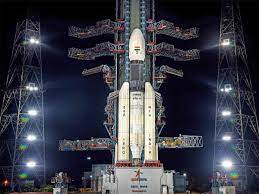05 Feb 2022 Mission Chandrayaan-3

- Recently information has been shared by the Department of Space that India plans to launch Chandrayaan-3 mission in August 2022.
Chandrayaan-3 Mission:
- The Chandrayaan-3 mission is a follow-up/successor mission to the July 2019 Chandrayaan-2 mission aimed at landing a rover on the Moon’s South Pole.
- After the failure of the Vikram lander, a need was felt to search for another mission to demonstrate landing capabilities, which is possible through the proposed Lunar Polar Exploration Mission in partnership with Japan in 2024.
- It will have an orbiter and a landing module. However, this orbiter will not be equipped with scientific instruments like Chandrayaan-2.
- Its work will be limited to taking the lander to the moon, monitoring the landing from its orbit and communication between the lander and the earth station.
Chandrayaan-2 Mission:
- Chandrayaan-2 consisted of an orbiter, lander and rover, all of which were equipped with scientific instruments to study the moons.
- The orbiter observed the Moon in an orbit of 100 km, while the lander and rover modules were separated to perform a soft landing on the lunar surface.
- ISRO named the lander module after Vikram, the pioneer of India’s space program Vikram Sarabhai and the rover module was named Pragyan which means- knowledge.
- It was flown by the country’s most powerful Geosynchronous Launch Vehicle, GSLV-Mk 3.
- However, instead of a controlled landing by Lander Vikram, a crash-landing took place due to which the rover Pragyan could not be successfully placed on the lunar surface.
GSLV-Mk 3:
- The Geosynchronous Satellite Launch Vehicle-Mk 3 (GSLV-Mk 3) is a high propulsion capability vehicle developed by the Indian Space Research Organization (ISRO). It is a three-stage vehicle designed to launch communication satellites into geostationary orbit.
- It has a mass of 640 tonnes which can place 8,000 kg payload into Low Earth Orbit (LEO) and 4000 kg payload into GTO (Geo-synchronous Transfer Orbit (GTO).
Types of Orbits:
Polar orbit:
- A polar orbit is an orbit in which a body or satellite passes over the poles from north to south and takes about 90 minutes to make one complete revolution.
- The inclination of these orbits is close to 90 degrees. From here almost every part of the earth can be seen by satellite as the earth rotates beneath it.
- These satellites have many applications such as monitoring of crops, global security, measuring ozone concentration in the stratosphere or measuring the temperature in the atmosphere.
- Almost all satellites in polar orbit have a low altitude.
- An orbit is said to be sun-synchronous because the angle between the center of the Earth and the line joining the satellite and the Sun remains constant throughout the orbit.
- These orbits, also known as “Low Earth Orbits (LEO)”, enable the onboard camera to take images of the Earth in the same sun-illuminated conditions during each trip. Thus it makes the satellite useful for monitoring the earth’s resources.
- It always passes over some point on the surface of the earth.
Geosynchronous Orbit:
- Geosynchronous satellites are launched into orbit in the same direction as the Earth is rotating.
- When the satellite is in orbit at a specific altitude (about 36,000 km from the Earth’s surface), it orbits at the same speed as the Earth is rotating.
- While geostationary orbits also fall under the category of geosynchronous orbits, they have the special property of being in orbits above the equator.
- In the case of geostationary satellites, the Earth’s gravitational force is sufficient to provide the necessary acceleration for circular motion.
- Geosynchronous Transfer Orbit (GTO): To achieve Geosynchronous Orbit or Geostationary Orbit, a spacecraft is first launched into Geosynchronous Transfer Orbit.
- From GTO the spacecraft uses its engines to move into geostationary and geosynchronous orbit.


No Comments